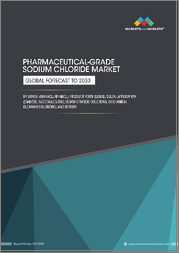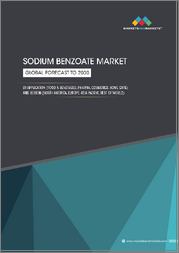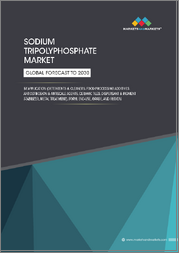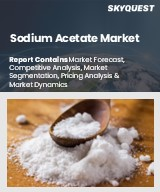
|
시장보고서
상품코드
1677264
세계의 요오드화나트륨(131I) 시장 : 유형, 제품 형태, 제조 방법, 용도, 최종 이용 산업별 - 예측(2025-2030년)Sodium Iodide [131I] Market by Type, Form, Production Method, Application, End-Use Industry - Global Forecast 2025-2030 |
||||||
요오드화나트륨(131I) 시장은 2024년 7억 3,680만 달러에서 2025년에는 7억 7,902만 달러에 이르고, 5.94%의 연평균 복합 성장률(CAGR)로 성장하여 2030년에는 10억 4,182만 달러에 달할 것으로 예상됩니다.
| 주요 시장 통계 | |
|---|---|
| 기준 연도 : 2024년 | 7억 3,680만 달러 |
| 추정 연도 : 2025년 | 7억 7,902만 달러 |
| 예측 연도 : 2030년 | 10억 4,182만 달러 |
| CAGR(%) | 5.94% |
요오드화나트륨(131I)은 현대 핵의학 및 산업 응용 분야에서 매우 중요한 역할을 하고 있으며, 치료와 진단 분야에서 전환점을 맞이하고 있습니다. 정밀한 개입에 대한 수요가 증가함에 따라 이 방사성 동위원소는 방사성의약품 제제 및 다양한 연구 이니셔티브에서 필수적인 요소로 자리 잡고 있습니다. 최근 기술 및 규제 조치의 발전은 제조 방법의 신뢰성을 강화하고 품질과 안전성이 최고 수준의 국제 표준을 충족하도록 보장합니다.
오늘날의 역동적인 환경에서 이해관계자들은 전통적인 방법론과 혁신적인 제조 기술을 결합하는 변화를 목격하고 있습니다. 요오드화나트륨(131I)의 진화는 임상적 우수성과 산업적 신뢰성을 뒷받침하는 보다 효율적이고 안전하며 비용 효율적인 방법론으로의 전환이라는 업계의 더 광범위한 추세를 반영하고 있습니다. 이 종합적인 분석은 영상진단, 방사선 치료, 과학연구에서 요오드화나트륨(131I)의 다각적인 역할을 탐구합니다. 각 개발은 산업 성장 모멘텀을 유지하기 위해 기술 통합과 규제 발전의 중요성을 강조합니다.
또한, 진화하는 시장 역학에 대한 통찰력은 엄격한 품질 관리와 진보적인 연구를 결합한 통합적 접근 방식이 요오드화나트륨(131I)의 생산과 응용을 획기적으로 강화할 수 있음을 시사합니다. 이 개괄적인 개요는 시장 세분화, 지역 동향 및 기업의 전략적 이니셔티브에 대한 후속 분석을 이해하는 데 필요한 배경 지식을 제공합니다.
생산, 응용, 시장 역학 변천사
지난 몇 년동안 요오드화나트륨(131I) 시장은 생산과 응용 측면에서 혁신적인 변화를 겪으며 재편되고 있습니다. 기업 및 연구기관은 제조 방법의 신뢰성과 효율성을 높이는 첨단 기술을 빠르게 도입하고 있습니다. 가속기 기반 및 원자로 기반 기술 혁신은 품질과 안전성을 유지하면서 생산 시간을 크게 단축시켰습니다.
이러한 변화는 정확한 영상 진단과 표적 치료가 중요한 개인 맞춤형 의료로의 전환으로 나타나고 있습니다. 이러한 변화는 제조 공정에서 핵심적인 역할을 하는 최첨단 선형 가속기 및 허드론 가속기에 대한 투자를 촉진하고 있습니다. 동시에 사이클로트론 조사 및 우라늄 핵분열로가 효율성과 안전성에 대한 새로운 기준에 적응하면서 전통적인 원자로 기반 생산이 개혁되고 있습니다.
이러한 변화는 규제 프레임워크와 운영 프로토콜을 지속적으로 검증하고 개선하기 위한 연구 증가에 의해 촉진되고 있습니다. 시장은 전통적인 방식에서 임상 및 산업 요구사항을 모두 충족하는 통합된 첨단 기술 솔루션으로 꾸준히 이동하고 있습니다. 오늘날의 상황은 역동적인 변화의 시대를 반영하고 있으며, 공동 전략과 기술 발전이 빠르게 진화하는 핵의학 및 연구 분야에서 혁신과 경쟁 우위를 촉진하고 있습니다.
생산, 형태, 용도, 최종 용도별 산업별 세분화 통찰력
요오드화나트륨(131I) 시장의 상세한 세분화 분석은 생산, 형태, 용도 및 최종 사용 산업의 다면성에 대응하는 복잡한 구조를 밝혀냈습니다. 첫째, 유형별로 보면 시장은 주로 순수 요오드화 나트륨(131I)과 방사성 의약품의 두 가지 범주로 구분됩니다. 이 분류는 제품의 이중적 특성을 강조하는 것으로, 단일 요소로서 또는 다양한 치료 절차에서 필수적인 구성 요소로 작용할 수 있습니다.
제품은 캡슐, 액체, 고체 등 다양한 형태로 제공되며, 각각의 형태는 투여 용이성, 안정성, 용량 정확성 등 다양한 장점을 제공합니다. 제품 형태는 다양한 임상 및 연구 현장의 특정 요구 사항을 충족하는 데 매우 중요합니다. 또한, 제조 방법도 중요한 세분화 매개변수입니다. 이 산업은 가속기 기반 제조와 원자로 기반 제조를 모두 활용하고 있습니다. 가속기 기반 접근법은 허드론 가속기 및 선형 가속기를 포함한 용도를 통해 더욱 정교해졌으며, 원자로 기반 생산은 사이클로트론 조사 및 우라늄 핵분열로를 활용합니다. 이러한 혁신적 방법을 통해 제조의 확장성과 진화하는 규제 표준에 대한 적응성을 보장합니다.
생산 기술뿐만 아니라, 시장은 용도에 따라 더욱 세분화됩니다. 산업 분야에서는 방사선 차폐 및 방사성 추적기와 같은 틈새 이용 사례에 대응하고 있습니다. 한편, 의료 분야는 특히 영상진단, 방사성 의약품 제조 및 치료 시술의 주요 수요처입니다. 또한, 화학 합성 및 핵의학 연구 분야에서의 연구 용도 역시 시장 확대의 원동력이 되고 있습니다. 마지막으로, 최종 사용 산업별로 세분화하면 학술 및 연구 기관, 화학 및 생명 공학 산업, 의료 및 제약 부문, 원자력 발전소까지 요오드화나트륨(131I)의 광범위한 시장 범위와 다양한 용도를 반영하는 광범위한 제품 범위가 강조됩니다.
목차
제1장 서문
제2장 조사 방법
제3장 주요 요약
제4장 시장 개요
제5장 시장 인사이트
- 시장 역학
- 성장 촉진요인
- 성장 억제요인
- 기회
- 과제
- 시장 세분화 분석
- Porter's Five Forces 분석
- PESTEL 분석
- 정치
- 경제
- 사회
- 기술
- 법률
- 환경
제6장 요오드화나트륨(131I) 시장 : 유형별
- 순수 요오드화나트륨(131I)
- 방사성 의약품
제7장 요오드화나트륨(131I) 시장 : 형태별
- 캡슐
- 액체
- 고체
제8장 요오드화나트륨(131I) 시장 : 제조 방법별
- 가속기 기반 생산
- 중성자 가속기
- 선형 가속기
- 원자로 기반 생산
- 사이클로트론 조사
- 우라늄 핵분열 반응기
제9장 요오드화나트륨(131I) 시장 : 용도별
- 산업
- 방사선 차폐
- 방사성 트레이서 응용
- 의학
- 진단 영상
- 방사성 의약품 제조
- 치료
- 연구
- 화학 합성
- 핵의학 연구
제10장 요오드화나트륨(131I) 시장 : 최종 이용 산업별
- 학술기관 및 연구기관
- 화학 및 바이오테크놀러지 산업
- 헬스케어 및 의약품
- 원자력 발전소
제11장 아메리카의 요오드화나트륨(131I) 시장
- 아르헨티나
- 브라질
- 캐나다
- 멕시코
- 미국
제12장 아시아태평양의 요오드화나트륨(131I) 시장
- 호주
- 중국
- 인도
- 인도네시아
- 일본
- 말레이시아
- 필리핀
- 싱가포르
- 한국
- 대만
- 태국
- 베트남
제13장 유럽, 중동 및 아프리카의 요오드화나트륨(131I) 시장
- 덴마크
- 이집트
- 핀란드
- 프랑스
- 독일
- 이스라엘
- 이탈리아
- 네덜란드
- 나이지리아
- 노르웨이
- 폴란드
- 카타르
- 러시아
- 사우디아라비아
- 남아프리카공화국
- 스페인
- 스웨덴
- 스위스
- 터키
- 아랍에미리트(UAE)
- 영국
제14장 경쟁 구도
- 시장 점유율 분석, 2024
- FPNV 포지셔닝 매트릭스, 2024
- 경쟁 시나리오 분석
- 전략 분석과 제안
기업 리스트
- Cardinal Health, Inc.
- China Isotope & Radiation Corporation
- Curium Pharma
- Eckert & Ziegler Radiopharma GmbH
- GE Healthcare, Inc.
- Institute of Isotopes Co., Ltd.
- International Isotopes Inc.
- Isotope JSC
- Jubilant DraxImage Inc.
- Mallinckrodt Pharmaceuticals
- MEDSNAB LLC
- Nordion Inc.
- NorthStar Medical Technologies, LLC
- NTP Radioisotopes SOC Ltd
- PDRadiopharma Inc.
- Shandong Xinhua Pharma
- Siemens Healthineers AG
- Telix Pharmaceuticals Limited
- Yantai Dongcheng Pharmaceutical Group Co. Ltd.
The Sodium Iodide [131I] Market was valued at USD 736.80 million in 2024 and is projected to grow to USD 779.02 million in 2025, with a CAGR of 5.94%, reaching USD 1,041.82 million by 2030.
| KEY MARKET STATISTICS | |
|---|---|
| Base Year [2024] | USD 736.80 million |
| Estimated Year [2025] | USD 779.02 million |
| Forecast Year [2030] | USD 1,041.82 million |
| CAGR (%) | 5.94% |
Sodium Iodide [131I] plays a pivotal role in modern nuclear medicine and industrial applications, marking a turning point in both therapeutic and diagnostic arenas. As the demand for precision interventions grows, this radioactive isotope has become an essential component in radiopharmaceutical formulations and various research initiatives. Recent advancements in technology and regulatory measures have bolstered the reliability of production methods, ensuring that both quality and safety meet the highest international standards.
In today's dynamic environment, stakeholders are witnessing a transformation that blends traditional methodologies with innovative production techniques. The evolution of Sodium Iodide [131I] is reflective of a broader trend within the industry-a shift toward more efficient, safe, and cost-effective practices that support clinical excellence and industrial reliability. In this comprehensive analysis, we explore the multifaceted roles of Sodium Iodide [131I] in diagnostic imaging, radiotherapeutic procedures, and scientific research. Each development underlines the importance of technological integration and regulatory advancements in maintaining the momentum of industry growth.
Moreover, insights into evolving market dynamics suggest that an integrated approach-combining rigorous quality control with progressive research-can dramatically enhance both the production and application of Sodium Iodide [131I]. This introductory overview provides the necessary context for understanding subsequent analyses on market segmentation, regional trends, and strategic company initiatives.
Transformative Shifts in Production, Application, and Market Dynamics
Over the past few years, the market for Sodium Iodide [131I] has experienced transformative shifts that are reshaping its landscape, both in production and application. Companies and institutions have been quick to adopt advanced technologies which enhance the reliability and efficiency of production methods. Innovations in accelerator-based and reactor-based techniques have significantly reduced production times while ensuring that quality and safety remain uncompromised.
The transformation is also evident in the shift towards personalized medicine, where accurate diagnostic imaging and targeted therapy are critical. This evolution has spurred investments in state-of-the-art linear accelerators and hadron accelerators that play a central role in the production process. Concurrently, traditional reactor-based production is undergoing reformation with cyclotron irradiation and uranium fission reactors adapting to newer standards of efficiency and safety.
These shifts are propelled by regulatory frameworks and a growing body of research that continually validates and refines operational protocols. The market is steadily transitioning from conventional practices towards integrated, high-tech solutions that meet both clinical and industrial demands. Today's landscape reflects an era of dynamic change, where collaborative strategies and technological advancements are driving both innovation and competitive advantage in the rapidly evolving field of nuclear medicine and research.
Segmentation Insights across Production, Form, Application, and End-use Industries
Detailed segmentation analysis of the Sodium Iodide [131I] market reveals a complex structure that caters to multiple facets of production, form, application, and end-user industries. First, when looking at the type, the market is distinguished by two primary categories: Pure Sodium Iodide [131I] and Radiopharmaceuticals. This classification underscores the dual nature of the product, serving as both a standalone element and an integral component in diverse therapeutic procedures.
The product is available in various forms including capsule, liquid, and solid, each offering its own set of benefits related to ease of administration, stability, and dosage accuracy. The form of the product is critical in ensuring that it meets the specific requirements of different clinical and research settings. In addition, the production method is another vital segmentation parameter. The industry capitalizes on both accelerator-based production and reactor-based production. Accelerator-based approaches are further refined by applications involving hadron accelerators and linear accelerators, whereas reactor-based production leverages cyclotron irradiation and uranium fission reactors. These innovative methodologies ensure that production is both scalable and adaptable to evolving regulatory standards.
Beyond production techniques, the market finds further segmentation based on application. The industrial segment addresses niche use-cases such as radiation shielding and radiotracer applications. Meanwhile, the medical sector is a primary consumer, particularly in diagnostic imaging, radiopharmaceutical production, and therapeutic procedures. Additionally, research applications in chemical synthesis and nuclear medicine research continue to drive market expansion. Finally, segmentation by end-use industry highlights the broad scope of these products-from academic and research institutions, chemical and biotechnology industries, to healthcare and pharmaceutical sectors, and even nuclear energy plants, thereby reflecting the extensive market reach and diverse application landscape of Sodium Iodide [131I].
Based on Type, market is studied across Pure Sodium Iodide [131I] and Radiopharmaceuticals.
Based on Form, market is studied across Capsule Form, Liquid Form, and Solid Form.
Based on Production Method, market is studied across Accelerator-Based Production and Reactor-Based Production. The Accelerator-Based Production is further studied across Hadron Accelerators and Linear Accelerators. The Reactor-Based Production is further studied across Cyclotron Irradiation and Uranium Fission Reactors.
Based on Application, market is studied across Industrial, Medical, and Research. The Industrial is further studied across Radiation Shielding and Radiotracer Applications. The Medical is further studied across Diagnostic Imaging, Radiopharmaceutical Production, and Therapeutic Procedures. The Research is further studied across Chemical Synthesis and Nuclear Medicine Research.
Based on End-Use Industry, market is studied across Academic & Research Institutions, Chemical & Biotechnology Industries, Healthcare & Pharmaceuticals, and Nuclear Energy Plants.
Regional Market Trends and Emerging Opportunities
The global landscape of the Sodium Iodide [131I] market is characterized by distinctive regional trends shaped by varying economic, regulatory, and technological factors. In the Americas, the market tends to be driven by robust healthcare infrastructure and significant investments in nuclear medicine. This is complemented by a mature industrial base that ensures steady demand for innovative radiopharmaceuticals.
In the Europe, Middle East & Africa region, regulatory frameworks and strategic partnerships play a definitive role in steering market growth. Here, rigorous quality standards and a commitment to technological advancement enhance the production efficiency and broaden the scope of applications. Meanwhile, the Asia-Pacific region is emerging as a key growth nexus, fueled by rapid industrialization, increasing healthcare expenditure, and collaborative research initiatives. The dynamism in this region is largely attributed to progressive regulatory amendments and heightened awareness regarding advanced diagnostic and therapeutic protocols.
Collectively, these regional insights highlight a diverse yet interlinked global market where localized trends coalesce to create a competitive environment. The evolving regulatory landscape, varying degrees of technological adoption, and growing consumer awareness are converging to promote sustainable growth in each region.
Based on Region, market is studied across Americas, Asia-Pacific, and Europe, Middle East & Africa. The Americas is further studied across Argentina, Brazil, Canada, Mexico, and United States. The United States is further studied across California, Florida, Illinois, New York, Ohio, Pennsylvania, and Texas. The Asia-Pacific is further studied across Australia, China, India, Indonesia, Japan, Malaysia, Philippines, Singapore, South Korea, Taiwan, Thailand, and Vietnam. The Europe, Middle East & Africa is further studied across Denmark, Egypt, Finland, France, Germany, Israel, Italy, Netherlands, Nigeria, Norway, Poland, Qatar, Russia, Saudi Arabia, South Africa, Spain, Sweden, Switzerland, Turkey, United Arab Emirates, and United Kingdom.
Key Industry Players Driving Market Innovation
Several key companies are instrumental in driving innovation and pushing the boundaries in the Sodium Iodide [131I] market. Industry leaders such as Cardinal Health, Inc. and China Isotope & Radiation Corporation are recognized for their pioneering production techniques and broad market reach. Firms like Curium Pharma and Eckert & Ziegler Radiopharma GmbH continue to innovate in radiopharmaceutical development, ensuring that advanced medical imaging and therapeutic procedures remain within reach for a global patient base.
Other influential players, including GE Healthcare, Inc. and the Institute of Isotopes Co., Ltd., have established themselves by consistently adhering to high industry standards and leveraging advanced technological infrastructures. The contributions of International Isotopes Inc. and Isotope JSC further illustrate the sector's commitment to quality and innovation. Moreover, companies such as Jubilant DraxImage Inc. and Mallinckrodt Pharmaceuticals have broadened the spectrum of applications by integrating cutting-edge research into their product lines.
Additional market influencers like MEDSNAB LLC, Nordion Inc., NorthStar Medical Technologies, LLC, and NTP Radioisotopes SOC Ltd have expanded offerings in both medical and industrial segments. Key collaborations and strategic investments by PDRadiopharma Inc., Shandong Xinhua Pharma, Siemens Healthineers AG, Telix Pharmaceuticals Limited, and Yantai Dongcheng Pharmaceutical Group Co. Ltd. further consolidate the sector's robust network of expertise, thereby driving the overall momentum and fostering a competitive environment in the global market.
The report delves into recent significant developments in the Sodium Iodide [131I] Market, highlighting leading vendors and their innovative profiles. These include Cardinal Health, Inc., China Isotope & Radiation Corporation, Curium Pharma, Eckert & Ziegler Radiopharma GmbH, GE Healthcare, Inc., Institute of Isotopes Co., Ltd., International Isotopes Inc., Isotope JSC, Jubilant DraxImage Inc., Mallinckrodt Pharmaceuticals, MEDSNAB LLC, Nordion Inc., NorthStar Medical Technologies, LLC, NTP Radioisotopes SOC Ltd, PDRadiopharma Inc., Shandong Xinhua Pharma, Siemens Healthineers AG, Telix Pharmaceuticals Limited, and Yantai Dongcheng Pharmaceutical Group Co. Ltd.. Actionable Recommendations for Strategy and Growth
Industry leaders can unlock significant growth opportunities by implementing actionable strategies that navigate the intricacies of the Sodium Iodide [131I] market. To maintain competitive advantage, companies should consider investing in advanced production technologies that ensure high quality and efficient output, particularly by embracing both accelerator-based and reactor-based methods. These investments will help in optimizing production workflows while reducing operational risks and costs.
In addition, integrating cross-functional collaborations between research institutions, healthcare providers, and industrial partners can foster groundbreaking innovation. Leaders are encouraged to leverage data-driven insights and market segmentation intelligence to tailor products for diverse applications-ranging from diagnostic imaging to industrial radiotracer applications. This multidimensional approach not only enhances product versatility but also addresses the specific needs of different end-user industries including academic, chemical, and pharmaceutical sectors.
Furthermore, capitalizing on emerging regional opportunities is paramount. An agile strategy that adapts to regional regulatory frameworks, consumer preferences, and technology adoption trends can drive market penetration. Companies should also prioritize investments in research and development, focusing on enhancing product efficacy and safety. By cultivating a culture of continuous improvement and innovation, industry leaders can enhance their market positioning, counter competitive pressures, and pave the way for sustainable growth.
Final Thoughts on Market Dynamics and Future Outlook
In summary, the evolution of the Sodium Iodide [131I] market is being driven by technological innovations, evolving regulatory mandates, and comprehensive segmentation strategies that cater to diverse applications. The integration of advanced production methodologies with customized solutions has positioned this market at the forefront of both industrial and medical advancements. Stakeholders now have a clearer roadmap for navigating an increasingly competitive landscape, where adaptability and strategic investments are key.
The concerted efforts by major industry players and regional markets are shaping a future where efficiency, quality, and innovation coalesce to form a robust market framework. This holistic overview not only highlights the current industry dynamics but also sets the stage for future advancements that promise to redefine therapeutic and diagnostic paradigms.
Table of Contents
1. Preface
- 1.1. Objectives of the Study
- 1.2. Market Segmentation & Coverage
- 1.3. Years Considered for the Study
- 1.4. Currency & Pricing
- 1.5. Language
- 1.6. Stakeholders
2. Research Methodology
- 2.1. Define: Research Objective
- 2.2. Determine: Research Design
- 2.3. Prepare: Research Instrument
- 2.4. Collect: Data Source
- 2.5. Analyze: Data Interpretation
- 2.6. Formulate: Data Verification
- 2.7. Publish: Research Report
- 2.8. Repeat: Report Update
3. Executive Summary
4. Market Overview
5. Market Insights
- 5.1. Market Dynamics
- 5.1.1. Drivers
- 5.1.1.1. Expanding use of sodium iodide [131I] for personalized treatment approaches in oncology, fueling market growth
- 5.1.1.2. Growing advancements in nuclear medicine and radiopharmaceutical technologies boosting the adoption of sodium iodide [131I] in diagnostics and treatment
- 5.1.1.3. Increasing need for targeted cancer therapies using sodium iodide [131I] for radioiodine therapy in thyroid cancer treatment
- 5.1.2. Restraints
- 5.1.2.1. Regulatory challenges and strict safety protocols for the manufacturing and handling of sodium iodide [131I] limiting market growth
- 5.1.3. Opportunities
- 5.1.3.1. Increasing research and development investments in sodium iodide [131I] to enhance its therapeutic applications and improve patient outcomes
- 5.1.3.2. Emergence of novel radioactive iodine-based therapies for rare cancers, providing new growth avenues for sodium iodide [131I] market players
- 5.1.4. Challenges
- 5.1.4.1. Potential side effects such as thyroid dysfunction and radiation exposure risks associated with sodium iodide [131I] therapy, affecting patient acceptance
- 5.1.1. Drivers
- 5.2. Market Segmentation Analysis
- 5.2.1. Type: Role of sodium iodide [131I] in radiopharmaceuticals for cancer treatment and diagnostics
- 5.2.2. End-Use Industry: Significance of sodium iodide [131I] in chemical & biotechnology industries for drug development and molecular imaging
- 5.3. Porter's Five Forces Analysis
- 5.3.1. Threat of New Entrants
- 5.3.2. Threat of Substitutes
- 5.3.3. Bargaining Power of Customers
- 5.3.4. Bargaining Power of Suppliers
- 5.3.5. Industry Rivalry
- 5.4. PESTLE Analysis
- 5.4.1. Political
- 5.4.2. Economic
- 5.4.3. Social
- 5.4.4. Technological
- 5.4.5. Legal
- 5.4.6. Environmental
6. Sodium Iodide [131I] Market, by Type
- 6.1. Introduction
- 6.2. Pure Sodium Iodide [131I]
- 6.3. Radiopharmaceuticals
7. Sodium Iodide [131I] Market, by Form
- 7.1. Introduction
- 7.2. Capsule Form
- 7.3. Liquid Form
- 7.4. Solid Form
8. Sodium Iodide [131I] Market, by Production Method
- 8.1. Introduction
- 8.2. Accelerator-Based Production
- 8.2.1. Hadron Accelerators
- 8.2.2. Linear Accelerators
- 8.3. Reactor-Based Production
- 8.3.1. Cyclotron Irradiation
- 8.3.2. Uranium Fission Reactors
9. Sodium Iodide [131I] Market, by Application
- 9.1. Introduction
- 9.2. Industrial
- 9.2.1. Radiation Shielding
- 9.2.2. Radiotracer Applications
- 9.3. Medical
- 9.3.1. Diagnostic Imaging
- 9.3.2. Radiopharmaceutical Production
- 9.3.3. Therapeutic Procedures
- 9.4. Research
- 9.4.1. Chemical Synthesis
- 9.4.2. Nuclear Medicine Research
10. Sodium Iodide [131I] Market, by End-Use Industry
- 10.1. Introduction
- 10.2. Academic & Research Institutions
- 10.3. Chemical & Biotechnology Industries
- 10.4. Healthcare & Pharmaceuticals
- 10.5. Nuclear Energy Plants
11. Americas Sodium Iodide [131I] Market
- 11.1. Introduction
- 11.2. Argentina
- 11.3. Brazil
- 11.4. Canada
- 11.5. Mexico
- 11.6. United States
12. Asia-Pacific Sodium Iodide [131I] Market
- 12.1. Introduction
- 12.2. Australia
- 12.3. China
- 12.4. India
- 12.5. Indonesia
- 12.6. Japan
- 12.7. Malaysia
- 12.8. Philippines
- 12.9. Singapore
- 12.10. South Korea
- 12.11. Taiwan
- 12.12. Thailand
- 12.13. Vietnam
13. Europe, Middle East & Africa Sodium Iodide [131I] Market
- 13.1. Introduction
- 13.2. Denmark
- 13.3. Egypt
- 13.4. Finland
- 13.5. France
- 13.6. Germany
- 13.7. Israel
- 13.8. Italy
- 13.9. Netherlands
- 13.10. Nigeria
- 13.11. Norway
- 13.12. Poland
- 13.13. Qatar
- 13.14. Russia
- 13.15. Saudi Arabia
- 13.16. South Africa
- 13.17. Spain
- 13.18. Sweden
- 13.19. Switzerland
- 13.20. Turkey
- 13.21. United Arab Emirates
- 13.22. United Kingdom
14. Competitive Landscape
- 14.1. Market Share Analysis, 2024
- 14.2. FPNV Positioning Matrix, 2024
- 14.3. Competitive Scenario Analysis
- 14.3.1. Sanofi ventures into radiopharmaceuticals with EUR 100 million deal for AlphaMedix
- 14.3.2. Study by Boston University reveals surgical and radioactive iodine treatments significantly lower cardiovascular risks in hyperthyroid patients
- 14.4. Strategy Analysis & Recommendation
Companies Mentioned
- 1. Cardinal Health, Inc.
- 2. China Isotope & Radiation Corporation
- 3. Curium Pharma
- 4. Eckert & Ziegler Radiopharma GmbH
- 5. GE Healthcare, Inc.
- 6. Institute of Isotopes Co., Ltd.
- 7. International Isotopes Inc.
- 8. Isotope JSC
- 9. Jubilant DraxImage Inc.
- 10. Mallinckrodt Pharmaceuticals
- 11. MEDSNAB LLC
- 12. Nordion Inc.
- 13. NorthStar Medical Technologies, LLC
- 14. NTP Radioisotopes SOC Ltd
- 15. PDRadiopharma Inc.
- 16. Shandong Xinhua Pharma
- 17. Siemens Healthineers AG
- 18. Telix Pharmaceuticals Limited
- 19. Yantai Dongcheng Pharmaceutical Group Co. Ltd.






